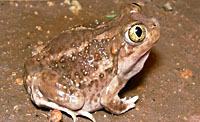Online Field Guide to The Reptiles and Amphibians of Arizona



Apache County, AZ
 Calling. Cochise Co., AZ |
| PLAINS SPADEFOOT Spea bombifrons | |
|
DESCRIPTION: The Plains spadefoot is typically a brown, reddish-brown, or olive spadefoot with a maximum length of about 2.5 inches. It has large eyes with vertical pupils, typical of spadefoots, and a bony boss between the eyes. There are often 4 light stripes down the back, the middle of which may form an hourglass. It is named for the wedge-shaped black, horny tubercle or spade on the bottom of each hind foot. This species is often confused with the Mexican spadefoot, with which it is often sympatric. The calls of the two species are quite distinct, and Mexican spadefoots typically smell like peanuts when handled. See the species description for the Mexican Spadefoot for other distinguishing characters. Tadpoles occur either as cannibalistic morphs that are large, flat-headed, and with enlarged jaw muscles; or as omnivores, which have a more rounded body shape and smaller jaw muscles. Both forms have relatively broad, flat heads with eyes close together and positioned high on the head. Tadpoles are gray or brown and grow to 2.75 inches. DISTRIBUTION: Valleys, plateaus, rolling hills, arroyo bottoms, and playas in northeastern Arizona north of Springerville and in southeastern Arizona around the base of the Chiricahua Mountains. HABITAT: This species occurs in open country characterized by grasslands, Great Basin Desert, or open, pinyon-juniper woodlands. It needs loose, well-drained soils for burrowing and aestivating, and ephemeral rain pools, playas, cattle ponds, or still water along arroyo bottoms with few or no predators for breeding. BEHAVIOR: Plains spadefoots are primarily nocturnal, but adults may be active during the day while breeding. Metamorphs are often diurnal as well. REPRODUCTION AND CALLS: Like other Arizona spadefoots, this species remains buried in the ground for months at a time and then emerges during heavy rainfall to breed and feed. It breeds in rain pools that form during the summer monsoons throughout its range in Arizona, but breeding in the spring may occur in northeastern Arizona, as well. Breeding occurs “explosively” the first night during or after a heavy rain. Males call from the shallows at the edge of the pond; the call is a rapid trill lasting less than a second, which is repeated at intervals of 0.5-1.0 second. Females lay up to 2,000 eggs in masses of 10 to 250 that are attached to vegetation or debris. Tadpoles hatch in 1-3 days and metamorphose in about 2-3 weeks. DIET: Plains spadefoots eat a variety of invertebrate prey, particularly nocturnal beetles, crickets, grasshoppers, and other small arthropods. As mentioned, tadpoles are either omnivorous or carnivorous. The former grows and develops relatively slowly compared to the carnivorous morph. Feeding fairy shrimp to omnivorous tadpoles can induce transformation to the carnivorous morph. Carnivorous tadpoles are commonly cannibalistic. REMARKS: Plains and Mexican spadefoots hybridize; hybrids and intergrades are especially common in the San Bernardino Valley and are best recognized by their intermediate mating call. By Jim Rorabaugh Degenhardt, W.G., C.W. Painter, and A.H. Price. 1996. Amphibians and Reptiles of New Mexico. University of New Mexico Press, Albuquerque. Dimmitt, M.A. 1990. Biology of desert toads with emphasis on spadefoots. Sonoran Herpetologist 3(7):62-65. Farrar, E., and J. Hay. 2005. Spea bombifrons Cope, 1863 Plains spadefoot. Pages 513-514 in M.J. Lannoo (ed), Amphibian Declines: The Conservation Status of United States Species. University of California Press, Berkeley, CA. Sullivan, B.K. 1989. Desert environments and the structure of anuran mating systems. Journal of Arid Environments 17(2):175-183. |
|
Visit Partners in Amphibian and Reptile Conservation:


HOME
Copyright © 2023, Arizona Game and Fish Department. All rights reserved.
If you make use of the textual contents of this site in reports, publications, etc. please cite and credit the author(s) and photographer(s). All photos on this website are copyrighted. However, those found in the species account section may be used for any noncommercial scientific, educational, or conservation purposes provided that photographs are not altered and continue to bear the copyright symbol and name of the photographer. Please contact the photographer regarding commercial use of copyrighted photographs.











